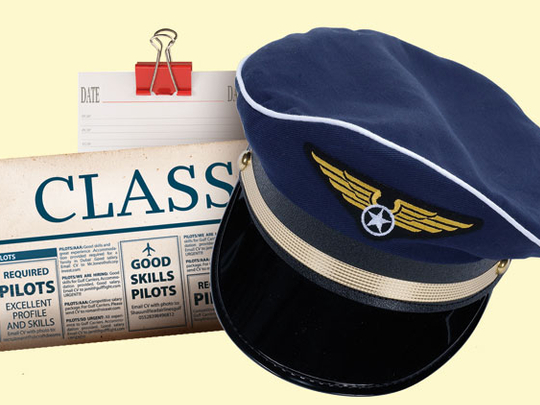
There is an old saying among pilots: "Take-off is optional; landing is mandatory."
It is somewhat the scenario with Gulf carriers at the moment. While they have all opted to take off with huge aircraft orders, the aviators to land those planes seem far and few.
After the recent Paris Air Show, the backlog from the Gulf carriers rests at more than 700 planes. "Those aircraft themselves will require between 4,900 and 6,300 pilots over the next few years as they are delivered. That is a considerable recruiting effort," points out Ernest S Arvai, president and CEO of The Arvai Group, an aviation consultancy.
Prior to the Paris event, Airbus had a backlog for "481 aircraft" from the region, and added to those totals with major orders at the show. "Qatar Airways' orders rested at 99 planes, Emirates 145 and Etihad 57 of that total before the Paris Air Show," said Arvai. "Similarly Boeing, through June 21, 2011, has a backlog of 212 from the region, with Emirates 47, Etihad 43, and Qatar Airways 39."
At present, UAE carriers employ well over 4,000 pilots altogether, with Emirates' pilot count resting at 2,687 First Officers and Captains, followed by over 1,000 pilots with Abu Dhabi-based Etihad Airways, 270 and 244 pilots with the two budget carriers Air Arabia and Flydubai respectively.
And an incredible number of planes is on the way. Emirates has 199 wide-bodied aircraft on order currently, worth more than $66 billion (Dh242.39 billion), a bulk of which is made up by the Airbus A380 superjumbos. Etihad, meanwhile, is due to take deliveries of "92 planes by the end 2012" to make a fleet of 155 aircraft. Its current fleet stands at 63 Airbus and Boeing planes, with an additional 100 planes on order, including 10 Airbus A380s. The carrier placed orders for up to 205 aircraft at the 2008 Farnborough Airshow, the firsts of which will be arriving this year, with the rest of the deliveries planned over the next 10 years.
The third of the ‘big three' Gulf carriers, Qatar Airways, meanwhile, is storming ahead fiercely harbouring an ambitious plan of flying more than 120 planes to an equal number of destinations by 2013. The Doha-based carrier's current total fleet size is a mix of 98 Boeing, Airbus and Bombardier aircraft.
Now, the question to raise is, are there enough pilots in the field to soak up most of this future capacity? "The pilot requirements for Gulf carriers will continue to grow, and unfortunately, at a faster rate than local Gulf pilots can be trained," points out Arvai. He further explained: "Typically, an airline needs seven to nine flight crews per aircraft to accommodate scheduling and rest periods required by regulations. So each time there is an order for 100 new aircraft, about 800 new pilots will be required."
Emirates, though, seems to have a plan in place and is aggressively recruiting pilots to fill in future needs. Kathryn Ferguson, Emirates' pilot recruitment manager, told Gulf News: "From April 2006 to March 2011, Emirates has hired almost 1,500 pilots. The target for this financial year [ending March 31, 2012] is the highest ever so far — over 500 pilots are required this fiscal. And over the next five years we will need approximately 1,750 pilots." In its last financial year, the Arab world's largest carrier hired 456 pilots of the 1,300 candidates that attended the airline's selection process, according to Ferguson. And this was an "increase from 88 pilots the previous year" which was when the economic crisis hit "and we stopped hiring for a period of time in 2008-2009".
Before that the airline recruited each year between 250 and 350 pilots. "The current increase in the target is dictated by the significant number of aircraft orders," Ferguson pointed out, admitting there is a demand for pilots in the region "as majority of Gulf airlines are actively recruiting at present".
An Etihad spokesperson said: "The number of pilots we recruit on a yearly basis varies from year to year, depending on various factors."
The newest flying kid on the block, two-year-old Flydubai, is also flapping wings to seek pilots' attention. The budget carrier's chief executive, Gaith Al Gaith says, the airline would need to recruit "another 600 pilots" [added to the current count of 244] over the next five years to operate the 50 aircraft Flydubai ordered from Boeing in 2008, the last of which is due to be delivered in 2016.
"We started operations just two years ago and as a start-up airline, we have been on a sustained recruitment drive," Al Gaith said, adding that the carrier has in that period built a fleet of "17 aircraft" and "38 operational destinations".
Asked if the increasing crunch for pilots in the region was something of a bother to the airline, Al Gaith said: "Flydubai has not experienced any problems so far in attracting talent." He added: "At Flydubai we only recruit the best calibre pilots, so our main challenge is finding candidates who meet our exemplary standards."
Air Arabia's spokesperson, echoing similar thoughts, said the budget carrier, which has a pilot workforce of 270 at present, faces "no shortage" in recruiting pilots at the moment.
Skill factor
Flydubai's Al Gaith, along with many others in the industry, raises a crucial point. After a point, it is not about finding pilots. The greater problem is finding "skilled" pilots for Gulf carriers. As consultant Arvai puts it: "Finding large numbers of experienced pilots can be a recruitment nightmare. Gulf carriers must now compete for a scarce resource."
Al Gaith adds: "The challenges faced in the Gulf are no different to those experienced elsewhere in the world. Every airline is seeking good quality pilots."
Looking westwards, where a lot of American — and also UK carriers, made pilots redundant in an aviation freefall amidst the economic downturn, the Gulf region has emerged as an attractive alternative for many skilled pilots in the recent couple of years.
"A significant number of our flight deck crew are coming from the UK and the US. Currently we have 383 pilots from the UK and 289 pilots from the US working with Emirates," Ferguson said.
"Every airline wants to save money. But pilots don't come cheap and the cost is rising as the supply dries up," warns Addison Schonland, a partner at AirInsight, an aviation and aerospace consultancy focused on industry competitive intelligence.
Sure enough, their [US and UK carriers'] loss is the Gulf's gain, in some way, but is the wind blowing back to the West now? Answers Arvai: "Fortunately, there are skilled pilots from the US and UK that have been laid off, but these days, with many being recalled and the level of pilots stabilising, the long-term outlook for this source is beginning to dry up."
He further warned: "The good news is that will take a few years, but Gulf carriers need to begin planning now to train an adequate number of Gulf residents to take those positions."
Attractions
Challenging Arvai's view is AirInsight's Schonland as he says: "Airlines, especially in the US, are not safe employment as they once were." Besides, Gulf carriers, according to him, offer some great attractions such as "salaries with tax advantages". He said: "Salaries are a key element of attracting pilots to the Gulf, and will continue to be. With full tax benefits for UK citizens and partial tax benefits for US citizens, those willing to relocate can find attractive salaries and career opportunities in the Gulf." Agrees Schonland: "Pilots can live a pretty nice lifestyle in the Gulf, and of course, travel privileges make home visits easy."
Emirates' Ferguson contests this view: "But asking pilots to move away from their home countries and families is a constant challenge faced by airlines in this part of the world." Without disclosing the remuneration package for pilots, she said: "We offer an attractive salary and benefits package which is quite competitive compared with other airlines and provides a very good standard of living."
That said, remuneration remains as a key element in attracting pilots to the Gulf, and will continue to be.
Flydubai, too, offers a "competitive" salary package to its pilots, says CEO Al Gaith.
Air Arabia, too, follows the industry standard in terms of salaries and benefits, its spokesperson said.
"While the Gulf carriers are better positioned in terms of salaries and living arrangements, the demand is ensuring that high costs continue," Arvai said.
Close competition and training pose challenges: With aviation picking up, there is an increase in demand for pilots worldwide
Threatening Gulf carriers' demand for pilots is strong competition from markets like India and China, which are currently growing at an unanticipated rate. As per a recent study by the Centre for Asia Pacific Aviation, India will need at least 90,000 crew, including pilots, to steer its aviation growth over the coming 20 years.
"China and India are experiencing a huge growth in aviation, and therefore, have a large demand for pilots in the future," said Kathryn Ferguson, Emirates' pilot recruitment manager.
Adds Flydubai's CEO Gaith Al Gaith: "There is a lot of competition both in the Gulf and the Far East, particularly China."
So with aviation picking up around the globe, there is an increase in the demand for pilots worldwide and therefore competition is strong, not within the region, but worldwide. "Pilots know they have a global talent — but there are limits. India wants to use local talent but has run into trouble with pilots flying who are unlicensed. China has some of this too — but it's been well hidden," said Addison Schonland, a partner at AirInsight.
"With Indian carriers facing the same problem, and placing orders for several hundred aircraft at Paris Air Show, Gulf carriers will need to compete with India for that talent, which is difficult," Arvai says.
Training is another major issue faced by the carriers. While new training facilities have emerged in the Gulf, the region is not graduating the number of pilots necessary to accommodate growth and retirements of the existing workforce, according to Arvai.
"That requires Gulf carriers to continue to utilise expatriates in the cockpit," he said. "Gulf carriers need to establish additional training academies and find locals to train to meet these critical requirements."
He added that unfortunately, weather in the Gulf doesn't always lend itself to flight training, and training had traditionally been done in the US in areas with good weather.
"With fewer pilots being trained in the US [student starts are down from 10 years ago by 20 per cent, reflecting lower salaries for US carriers and the relative attractiveness of being a pilot with other careers] over the longer-term that pipeline will be gone," points out Ernest S Arvai, president and CEO of The Arvai Group, an aviation consultancy.
Flydubai's Al Gaith begs to differ. "With prospects for state-of-the-art training and great opportunities for personal advancement in the Gulf, career as a pilot is gaining currency among the local population," he says.
According to a recent report by the Saudi Aviation Flight Academy (Safa), aviation colleges in six Gulf countries train less than 1,000 new pilots a year, creating a significant supply gap that threatens to stall the growth of local carriers. Roger that…?












